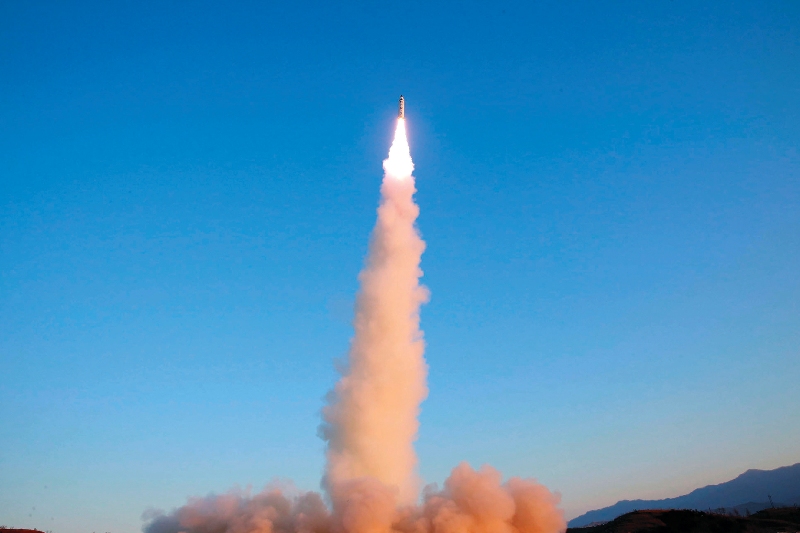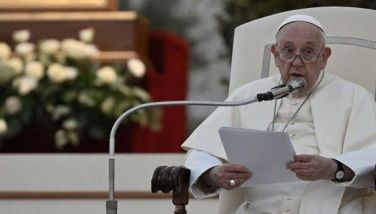North Korea missile fear sets pre-emptive strike debate in Japan

In this Sunday, Feb. 12, 2017, photo distributed on Monday, Feb. 13, 2017, by the North Korean government, "Pukguksong-2” is launched at an undisclosed location in North Korea. Independent journalists were not given access to cover the event depicted in this image distributed by the Korean Central News Agency via Korea News Service. The "Pukguksong-2" the North's Korean Central News Agency said was a "Korean style new type strategic weapon system." Korean Central News Agency/Korea News Service via AP, file
TOKYO — Japan is debating whether to develop a limited pre-emptive strike capability and buy cruise missiles — ideas that were anathema in the pacifist country before the North Korea missile threat. With revisions to Japan's defense plans underway, ruling party hawks are accelerating the moves, and some defense experts say Japan should at least consider them.
After being on the backburner in the ruling party for decades, a possibility of pre-emptive strike was formally proposed to Prime Minister Shinzo Abe by his party's missile defense panel in March, prompting parliamentary debate, though somewhat lost steam as Abe apparently avoided the divisive topic after seeing support ratings for his scandal-laden government plunge.
North Korea's test-firing Tuesday of a missile, which flew over Japan and landed in the northern Pacific Ocean, has intensified fear and reignited the debate.
"Should we possess pre-emptive strike capability?" liberal-leaning Mainichi newspaper asked the following day. "But isn't it too reckless to jump to discuss a 'get them before they get you' approach?"
Japan has a two-step missile defense system. First, Standard Missile-3 interceptors on Aegis destroyers in the Sea of Japan would shoot down projectiles mid-flight and if that fails, surface-to-air PAC-3s would intercept them from within a 20-kilometer (12-mile) range. Technically, the setup can handle falling debris or missiles heading to Japan, but it's not good enough for missiles on a high-lofted trajectory, those with multiple warheads or simultaneous multiple attacks, experts say.
A pre-emptive strike, by Japanese definition, is a step preceding the two-tier defense. Cruise missiles, such as Tomahawk, fired from Aegis destroyers or fighter jets would get the enemy missile clearly waiting to be fired, or just after blastoff from a North Korean launch site, before it approaches Japan.
Japan's self-defense-only principle under the country's war-renouncing constitution prohibits its military from making a first strike, and officials discussing a limited pre-emptive strike are calling it a "strike-back" instead. Whichever the language, it further loosens postwar Japan's pacifist principle and could strain its relations with China, which is suspicious of Tokyo's intentions. There are gray areas as to how far Japan can go and still justify minimum self-defense.
Some experts are skeptical about how it would work. North Korea's secretive, diversified and mobile launch system makes it extremely difficult to track down and incapacitate the weapons with Japan's limited cruise missile attacks, security expert Ken Jimbo at Keio University said in a recent article. A pre-emptive strike capability would also require trillions of dollars to set up spy satellites, reconnaissance aircraft, cruise missiles, as well as training of special units, experts say.
North Korea flight-tested two intercontinental ballistic missiles in July and has threatened to send missiles near the U.S. territory of Guam, home to key military bases. The North already has short-range missiles that cover Japan and possibly has achieved miniaturized nuclear warheads, the Defense Ministry's annual report says.
"North Korea has demonstrated its capability to hit targets anywhere in Japan," said Narushige Michishita, a defense expert at the National Graduate Institute for Policy Studies. "It has become even more important for Japan to improve its missile and civil defense capabilities, and seriously think about acquiring limited but meaningful strike capabilities."
Timing of the pre-emptive strike debate is seen in favor of supporters of the option in the ruling party and the Defense Ministry because they are just starting to revise Japan's multi-year defense plans.
Abe called Tuesday's missile firing "unprecedented, grave and serious threat." Defense Minister Itsunori Onodera, an advocate of bolstering Japan's missile and strike-back capability, said more provocations by the North are likely and Tokyo must quickly upgrade its missile arsenal.
The Defense Ministry announced Thursday a record 5.26 trillion yen ($48 billion) budget for fiscal 2018, which would cover purchase of upgraded missile defense systems such as land-based Aegis Ashore interceptors or the Terminal High-Altitude Area Defense, or THAAD, a mobile equipment Washington and Seoul have installed in South Korea. Beijing, which says THAAD's powerful radar can reach deep into China and wants it removed, could react sharply if it is installed in Japan.
Abe, since taking office five years ago, has expanded Japan's military role, allowing it to take on a greater task in international peacekeeping. In 2015, his government allowed Japan to fight for its allies when they come under enemy attack, a condition known as collective self-defense, by re-interpreting part of the constitution and railroading a new security legislation that sparked massive protests.
Pre-emptive strike, however, is even more sensitive and divisive topic and the government may have to prioritize upgrading missile interceptors for now, says Tetsuo Kotani, senior research fellow at the Japan Institute of International Affairs. Polls show most Japanese fear North Korea's missile threat and support bolstering Japan's intercepting capability, but in terms of pre-emptive strike, opponents overwhelmed supporters.
"Prime Minister Abe seems to have turned hesitant about discussing pre-emptive strikes," Kotani said, suggesting Abe's declining popularity is causing his reluctance to push the issue. "Public debate of pre-emptive strikes may slow down."
- Latest
- Trending
































